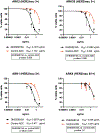DHES0815A, a novel antibody-drug conjugate targeting HER2/neu, is highly active against uterine serous carcinomas in vitro and in vivo
- PMID: 34452746
- PMCID: PMC8722447
- DOI: 10.1016/j.ygyno.2021.08.014
DHES0815A, a novel antibody-drug conjugate targeting HER2/neu, is highly active against uterine serous carcinomas in vitro and in vivo
Abstract
Objective: Uterine serous carcinoma (USC) is an aggressive histologic variant of endometrial cancer which portends a poor prognosis. DHES0815A is a novel antibody-drug-conjugate (ADC) which binds specifically to HER2 overexpressing tumors at a distinct epitope from that bound by trastuzumab and pertuzumab after which it delivers the toxic payload, PBD-MA, a DNA mono-alkylating agent. The objective of this study was to evaluate the preclinical activity of DHES0815A against primary USC cell lines and xenografts.
Methods: Twelve primary USC cell lines were assessed by immunohistochemistry (IHC) for HER2 protein expression and for C-erbB2 gene amplification using fluorescent in situ hybridization (FISH) analysis. Cell viability and bystander killing in USC cell lines after exposure to DHES0815A, the non-targeted ADC, and the unconjugated antibody (i.e. MHES0488A) were evaluated using flow cytometry-based-assays. In vivo activity of DHES0815A was tested against HER2/neu overexpressing USC xenografts.
Results: High HER2/neu protein expression was seen in 25% (3/12) of the primary USC cell lines. USC cell lines overexpressing HER2/neu were significantly more sensitive to DHES0815A when compared to the non-targeted control ADC (p < 0.001). DHES0815A did not induce significant bystander killing of HER2/neu negative tumors when admixed with HER2/neu positive tumors. DHES0815A caused growth-inhibition and increased survival in USC HER2/neu overexpressing xenografts when compared to controls (p < 0.01).
Conclusions: DHES0815A is both highly selective and toxic to USC tumors overexpressing HER2/neu both in vitro and in vivo. HER2-directed ADCs, alone or in combination with other HER2/neu targeted agents may represent a novel treatment option for patients with tumors harboring HER2/neu overexpression refractory to trastuzumab and traditional chemotherapy.
Keywords: Antibody drug conjugate (ADC); DHES0815A; Uterine cancer; Uterine serous carcinoma.
Copyright © 2021 Elsevier Inc. All rights reserved.
Conflict of interest statement
Declaration of Competing Interest All authors fulfill the conditions required for authorship. Dr. Santin reports grants from PUMA, grants from IMMUNOMEDICS, grants from GILEAD, grants from SYNTHON, grants from MERCK, grants from BOEHINGER-INGELHEIM, grants from GENENTECH, grants from TESARO, during the conduct of the study. A.M. declares that she receives research-funding support from Spanish Medical Oncology Society. D.A.S reports Intuitive Surgical, Medtronic, Olympus, and Zai Lab consultant/speaker fees.
Figures



Similar articles
-
SYD985, a Novel Duocarmycin-Based HER2-Targeting Antibody-Drug Conjugate, Shows Antitumor Activity in Uterine Serous Carcinoma with HER2/Neu Expression.Mol Cancer Ther. 2016 Aug;15(8):1900-9. doi: 10.1158/1535-7163.MCT-16-0163. Epub 2016 Jun 2. Mol Cancer Ther. 2016. PMID: 27256376
-
In vitro and in vivo activity of sacituzumab govitecan, an antibody-drug conjugate targeting trophoblast cell-surface antigen 2 (Trop-2) in uterine serous carcinoma.Gynecol Oncol. 2020 Feb;156(2):430-438. doi: 10.1016/j.ygyno.2019.11.018. Epub 2019 Dec 12. Gynecol Oncol. 2020. PMID: 31839338
-
T-DM1, a novel antibody-drug conjugate, is highly effective against primary HER2 overexpressing uterine serous carcinoma in vitro and in vivo.Cancer Med. 2014 Oct;3(5):1256-65. doi: 10.1002/cam4.274. Epub 2014 Jun 2. Cancer Med. 2014. PMID: 24890382 Free PMC article.
-
HER2/neu as a Signaling and Therapeutic Marker in Uterine Serous Carcinoma.Cells. 2025 Aug 19;14(16):1282. doi: 10.3390/cells14161282. Cells. 2025. PMID: 40862761 Free PMC article. Review.
-
Mechanisms of resistance to HER2-targeted therapies in HER2-amplified uterine serous carcinoma, and strategies to overcome it.Discov Med. 2018 Aug;26(141):39-50. Discov Med. 2018. PMID: 30265854 Review.
Cited by
-
Entering the golden age for antibody-drug conjugates in gynecologic cancer.Oncoscience. 2024 May 20;11:51-52. doi: 10.18632/oncoscience.604. eCollection 2024. Oncoscience. 2024. PMID: 38770444 Free PMC article. No abstract available.
-
Clinical perspective: Antibody-drug conjugates for the treatment of HER2-positive breast cancer.Mol Ther. 2023 Jul 5;31(7):1874-1903. doi: 10.1016/j.ymthe.2023.03.019. Epub 2023 Mar 22. Mol Ther. 2023. PMID: 36950736 Free PMC article. Review.
-
Antibody-Drug Conjugates (ADC) in HER2/neu-Positive Gynecologic Tumors.Molecules. 2023 Nov 2;28(21):7389. doi: 10.3390/molecules28217389. Molecules. 2023. PMID: 37959808 Free PMC article. Review.
-
Narrative review on the evolving role of HER2/neu targeting in uterine serous cancers.Ann Transl Med. 2024 Aug 1;12(4):69. doi: 10.21037/atm-23-1465. Epub 2023 Nov 9. Ann Transl Med. 2024. PMID: 39118940 Free PMC article. Review.
-
The development and evaluation of a tublysine-based antibody-drug conjugate with enhanced tumor therapeutic efficacy.Front Pharmacol. 2025 Feb 10;16:1532104. doi: 10.3389/fphar.2025.1532104. eCollection 2025. Front Pharmacol. 2025. PMID: 39995411 Free PMC article.
References
-
- Siegel RL, Miller KD, Jemal A. Cancer statistics, 2020 CA Cancer J Clin. 2020. 2020; 70:7–30. - PubMed
-
- Siegel RL, Miller KD, Jemal A. Cancer statistics, 2019. CA Cancer J Clin. 2019; 69:7–34. - PubMed
-
- Bokhman JV. Two pathogenetic types of endometrial carcinoma. Gynecol Oncol 1983; 15:10. - PubMed
-
- Slomovitz BM, Burke TW, Eifel PJ, et al. Uterine papillary serous carcinoma (UPSC): a single institution review of 129 cases. Gynecol Oncol 2003; 91:463. - PubMed
Publication types
MeSH terms
Substances
Grants and funding
LinkOut - more resources
Full Text Sources
Medical
Research Materials
Miscellaneous

